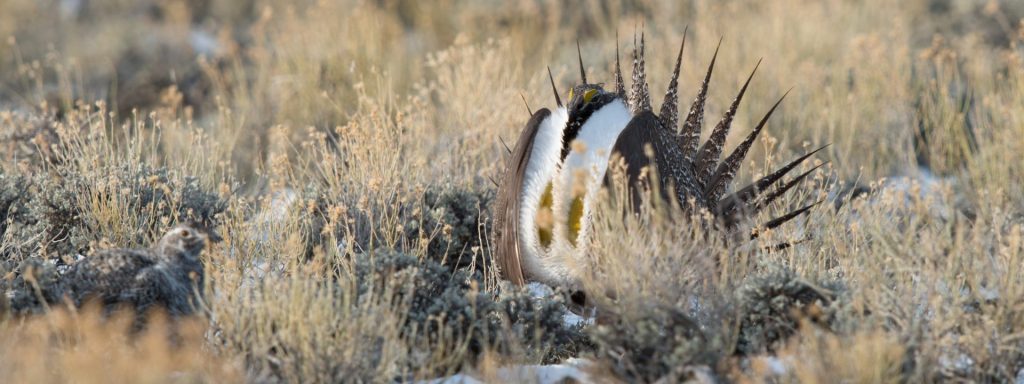Wyoming Otter Conservation: A Pivotal Moment For Management

Table of Contents
Current Status of Otter Populations in Wyoming
Precisely quantifying Wyoming's otter population remains a challenge, hindering comprehensive conservation planning. While a thriving population is not confirmed, data suggests a relatively stable, though potentially vulnerable, presence across the state. Otters are primarily found along major river systems and lakes, their distribution influenced by habitat availability and water quality. Population trend data over the past decade is limited, requiring further research to fully understand the long-term dynamics.
- Specific river systems with significant otter populations: The Snake River, Green River, and North Platte River support notable otter populations. However, precise population numbers within these systems are still being investigated.
- Areas where otter sightings are rare or declining: Smaller, isolated waterways and areas with degraded habitat show significantly fewer otter sightings. Further research is needed to confirm population trends in these areas.
- Data sources used for population estimates: Current population estimates rely on a combination of field surveys, track surveys, and opportunistic sightings reported by the public and wildlife officials. More comprehensive, standardized monitoring programs are necessary.
Threats to Wyoming Otters
Several interconnected factors threaten the long-term survival of Wyoming otters. These threats necessitate a holistic conservation approach to effectively mitigate risks.
Habitat Loss and Degradation
Human activities significantly impact otter habitats. Development, agricultural practices, and water resource management projects fragment and degrade vital riparian ecosystems.
- Examples of habitat loss due to dam construction or irrigation projects: Dam construction alters natural river flows, impacting water quality and availability of suitable habitat for otters. Irrigation projects can reduce water flow and alter riparian vegetation, diminishing foraging opportunities.
- Impact of water pollution on otter health and survival: Pollution from agricultural runoff (pesticides, fertilizers) and industrial waste contaminates water, harming otters directly and impacting their prey base. Heavy metal accumulation can also lead to bioaccumulation in otters, affecting their reproductive success and overall health.
- Effects of riparian vegetation removal: Removal of riparian vegetation for development or agricultural purposes reduces crucial habitat elements such as cover, denning sites, and foraging areas.
Water Quality Issues
Water pollution poses a major threat to Wyoming otters. Various pollutants negatively affect both otter health and their food sources, leading to reduced populations and compromised ecosystems.
- Specific pollutants affecting otter populations: Agricultural runoff containing pesticides and herbicides, industrial waste containing heavy metals, and untreated sewage are significant sources of water pollution that endanger otters.
- Consequences of water contamination on prey species: Pollution affects the abundance and health of fish and other aquatic species that form the otter's diet. Reduced prey availability negatively impacts otter survival and reproduction.
- Link between water quality and otter reproductive success: Studies have shown a correlation between water quality and otter reproductive rates. Poor water quality can lead to reduced reproductive success and compromised offspring survival.
Predation and Disease
While natural predation is a normal ecological process, increased human-wildlife conflict can exacerbate predation pressures. Furthermore, infectious diseases can devastate otter populations.
- Identification of major predators: Coyotes, wolves, and occasionally bears can prey on otters, particularly young or vulnerable individuals.
- Diseases impacting otter populations: Diseases like canine distemper virus and toxoplasmosis can affect otter health and survival.
- Impact of human-wildlife conflict: Human activities, such as road construction and habitat fragmentation, increase the vulnerability of otters to predation by bringing them into closer contact with predators.
Ongoing Conservation Efforts
Several initiatives aim to protect Wyoming otters. These efforts are crucial, but require further strengthening and collaboration.
Government Initiatives
State and federal agencies play a crucial role in Wyoming otter conservation, implementing various programs.
- Specific government agencies involved: The Wyoming Game and Fish Department and the U.S. Fish and Wildlife Service are key players in otter conservation efforts.
- Types of programs: These agencies undertake habitat restoration projects, conduct population monitoring surveys, and fund research initiatives aimed at understanding and addressing threats to otter populations.
- Funding allocated for otter conservation: Securing adequate funding for research, habitat restoration, and monitoring programs remains a priority for effective Wyoming otter conservation.
Non-profit Organizations
Non-governmental organizations (NGOs) are vital partners in Wyoming otter conservation efforts.
- Names of key organizations: Several conservation groups actively support Wyoming otter conservation. Identifying these organizations and highlighting their contributions would be beneficial here.
- Types of conservation efforts undertaken: NGOs often conduct educational outreach, organize fundraising events, and collaborate on habitat protection and restoration projects.
- Examples of successful conservation projects: Highlighting successful collaborations and initiatives by NGOs would showcase the positive impact of their efforts.
Citizen Science and Community Involvement
Public engagement is crucial for successful Wyoming otter conservation. Citizen science initiatives and awareness campaigns can significantly contribute to monitoring and protecting otter populations.
- Opportunities for citizen scientists to contribute: Public participation in otter monitoring programs through data collection and reporting can significantly aid conservation efforts.
- Importance of public awareness campaigns: Educational campaigns can increase public awareness of otter conservation issues and encourage responsible actions to protect otters and their habitats.
- Ways individuals can help with otter conservation: Supporting conservation organizations, reducing pollution, and advocating for responsible land and water management are all ways individuals can help.
Future Directions for Wyoming Otter Conservation
Effective Wyoming otter conservation demands a collaborative, science-driven approach.
- Need for collaborative efforts: Stronger partnerships between government agencies, NGOs, and the public are vital for coordinated conservation strategies.
- Importance of long-term monitoring and research: Continuous monitoring of otter populations and their habitats is crucial for evaluating the effectiveness of conservation measures and adapting strategies as needed.
- Need for adaptive management strategies: Conservation plans should be flexible and responsive to new information and emerging challenges.
- Specific actions for improving habitat protection and water quality: Implementing stricter regulations on pollution, restoring degraded habitats, and ensuring sustainable water management are key actions to protect otters.
- Specific policy recommendations for improved conservation efforts: Advocating for policies that promote habitat protection, water quality improvement, and responsible land use is essential.
- Future research priorities: Prioritizing research on factors affecting otter population dynamics, disease prevalence, and habitat use will improve conservation efforts.
- Long-term goals for Wyoming otter populations: Establishing long-term population goals and objectives that are scientifically grounded and achievable is essential for guiding future conservation actions.
Conclusion
The future of Wyoming otter conservation depends on a multifaceted approach that combines robust scientific research, effective government policies, dedicated conservation efforts from NGOs, and active public participation. By understanding the current threats and implementing comprehensive strategies, we can work towards ensuring a healthy and thriving otter population in Wyoming for generations to come. Learn more about how you can contribute to Wyoming otter conservation and get involved today! Support organizations dedicated to protecting these fascinating animals and help make a difference in their survival.

Featured Posts
-
 Cassis Blackcurrant Liqueur Production Taste And Uses
May 22, 2025
Cassis Blackcurrant Liqueur Production Taste And Uses
May 22, 2025 -
 Pat Mc Afee Show Insider Refutes Aaron Rodgers Trade To Steelers
May 22, 2025
Pat Mc Afee Show Insider Refutes Aaron Rodgers Trade To Steelers
May 22, 2025 -
 Gumballs World A New Era Of Weirdness Teaser
May 22, 2025
Gumballs World A New Era Of Weirdness Teaser
May 22, 2025 -
 Stephane De La Suisse A Paris L Ascension D Une Chanteuse
May 22, 2025
Stephane De La Suisse A Paris L Ascension D Une Chanteuse
May 22, 2025 -
 Wife Of Ex Tory Councillor Challenges Racial Hate Tweet Conviction
May 22, 2025
Wife Of Ex Tory Councillor Challenges Racial Hate Tweet Conviction
May 22, 2025
Latest Posts
-
 Should The Steelers Trade For An Nfc Quarterback A Bold Prediction
May 22, 2025
Should The Steelers Trade For An Nfc Quarterback A Bold Prediction
May 22, 2025 -
 Steelers Trade Proposal A Shocking Nfc Quarterback Acquisition
May 22, 2025
Steelers Trade Proposal A Shocking Nfc Quarterback Acquisition
May 22, 2025 -
 Steelers Hold Onto Pickens An Insiders View On The Trade Deadline
May 22, 2025
Steelers Hold Onto Pickens An Insiders View On The Trade Deadline
May 22, 2025 -
 George Pickens Trade Rumors An Insiders Account Of The Steelers Stance
May 22, 2025
George Pickens Trade Rumors An Insiders Account Of The Steelers Stance
May 22, 2025 -
 Steelers Schedule Release A Deep Dive Into The Takeaways
May 22, 2025
Steelers Schedule Release A Deep Dive Into The Takeaways
May 22, 2025
